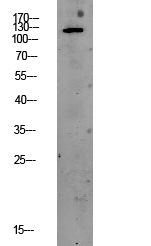Total PEK/PERK Cell-Based Colorimetric ELISA Kit
- Catalog No.:KA4229C
- Applications:ELISA
- Reactivity:Human;Mouse;Rat
- Gene Name:
- EIF2AK3
- Human Gene Id:
- 9451
- Human Swiss Prot No:
- Q9NZJ5
- Mouse Swiss Prot No:
- Q9Z2B5
- Rat Swiss Prot No:
- Q9Z1Z1
- Storage Stability:
- 2-8°C/6 months
- Other Name:
- Eukaryotic translation initiation factor 2-alpha kinase 3 (EC 2.7.11.1) (PRKR-like endoplasmic reticulum kinase) (Pancreatic eIF2-alpha kinase) (HsPEK)
- Detection Method:
- Colorimetric
- Background:
- catalytic activity:ATP + a protein = ADP + a phosphoprotein.,disease:Defects in EIF2AK3 are the cause of Wolcott-Rallison syndrome (WRS) [MIM:226980]; also known as multiple epiphyseal dysplasia with early-onset diabetes mellitus. WRS is a rare autosomal recessive disorder, characterized by permanent neonatal or early infancy insulin-dependent diabetes and, at a later age, epiphyseal dysplasia, osteoporosis, growth retardation and other multisystem manifestations, such as hepatic and renal dysfunctions, mental retardation and cardiovascular abnormalities.,domain:The lumenal domain senses perturbations in protein folding in the ER, probably through reversible interaction with HSPA5/BIP.,enzyme regulation:Perturbation in protein folding in the endoplasmic reticulum (ER) promotes reversible dissociation from HSPA5/BIP and oligomerization, resulting in transautophosphorylation and kinase activity induction.,function:Phosphorylates the alpha subunit of eukaryotic translation-initiation factor 2 (EIF2), leading to its inactivation and thus to a rapid reduction of translational initiation and repression of global protein synthesis. Serves as a critical effector of unfolded protein response (UPR)-induced G1 growth arrest due to the loss of cyclin D1.,induction:By ER stress.,PTM:Autophosphorylated.,PTM:N-glycosylated.,similarity:Belongs to the protein kinase superfamily.,similarity:Belongs to the protein kinase superfamily. Ser/Thr protein kinase family. GCN2 subfamily.,similarity:Contains 1 protein kinase domain.,subunit:Forms dimers with HSPA5/BIP in resting cells. Oligomerizes in ER-stressed cells. Interacts with DNAJC3.,tissue specificity:Ubiquitous. A high level expression is seen in secretory tissues.,
- Function:
- skeletal system development, ossification, chondrocyte differentiation, chondrocyte development, peptide secretion,generation of a signal involved in cell-cell signaling, translation, regulation of translation, regulation of translational initiation, protein complex assembly, protein amino acid phosphorylation, phosphorus metabolic process, phosphate metabolic process, apoptosis, activation of caspase activity, virus-infected cell apoptosis, ER overload response, ER-nuclear signaling pathway, response to unfolded protein, endoplasmic reticulum organization, cell surface receptor linked signal transduction, enzyme linked receptor protein signaling pathway, transmembrane receptor protein tyrosine kinase signaling pathway, intracellular signaling cascade, cell-cell signaling, cell death, negative regulation of biosynthetic process, hormone transport, response to organic substance, negative
- Subcellular Location:
- Endoplasmic reticulum membrane; Single-pass type I membrane protein.
- Expression:
- Ubiquitous. A high level expression is seen in secretory tissues.
- June 19-2018
- WESTERN IMMUNOBLOTTING PROTOCOL
- June 19-2018
- IMMUNOHISTOCHEMISTRY-PARAFFIN PROTOCOL
- June 19-2018
- IMMUNOFLUORESCENCE PROTOCOL
- September 08-2020
- FLOW-CYTOMEYRT-PROTOCOL
- May 20-2022
- Cell-Based ELISA│解您多样本WB检测之困扰
- July 13-2018
- CELL-BASED-ELISA-PROTOCOL-FOR-ACETYL-PROTEIN
- July 13-2018
- CELL-BASED-ELISA-PROTOCOL-FOR-PHOSPHO-PROTEIN
- July 13-2018
- Antibody-FAQs

.jpg)
